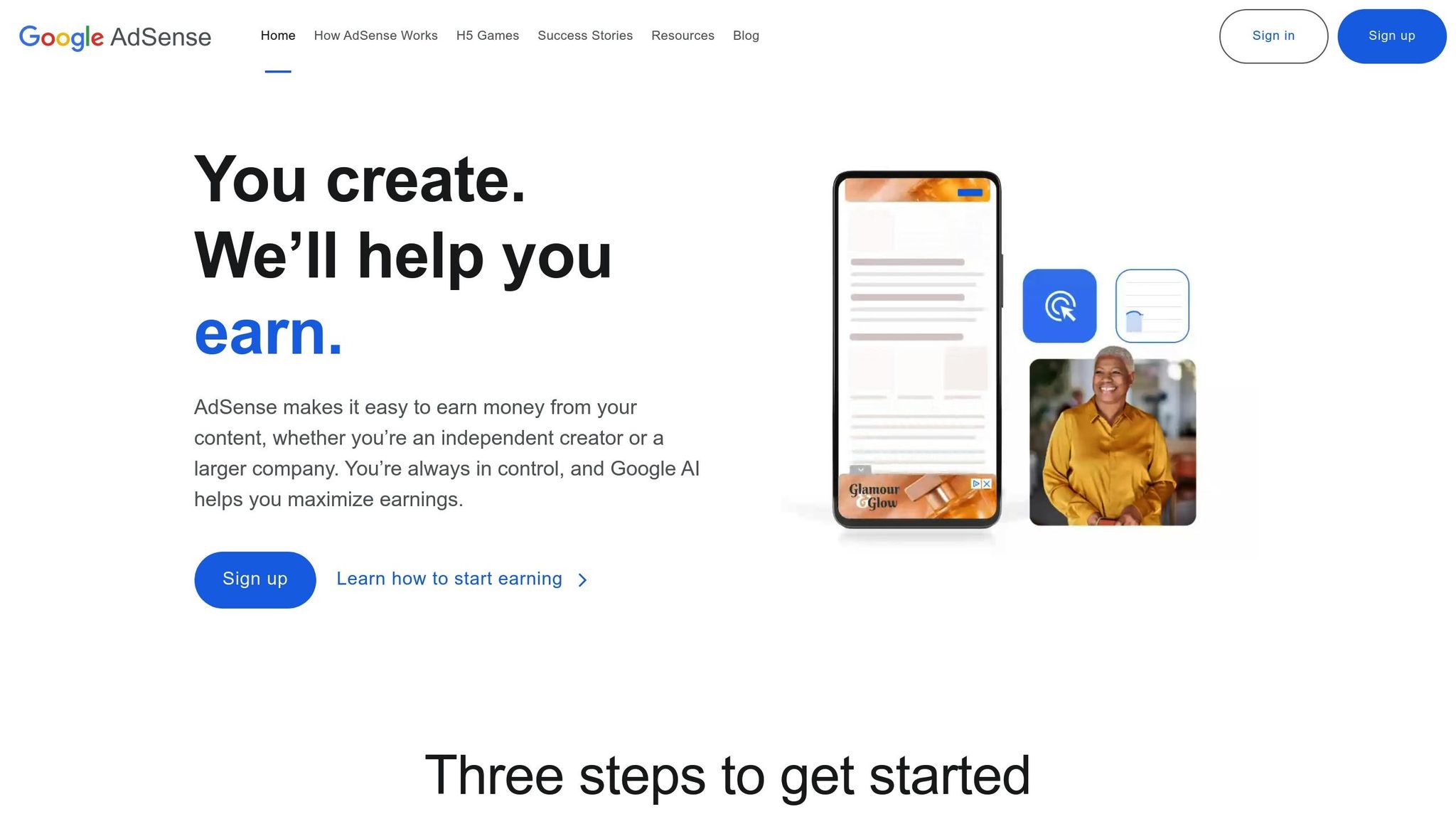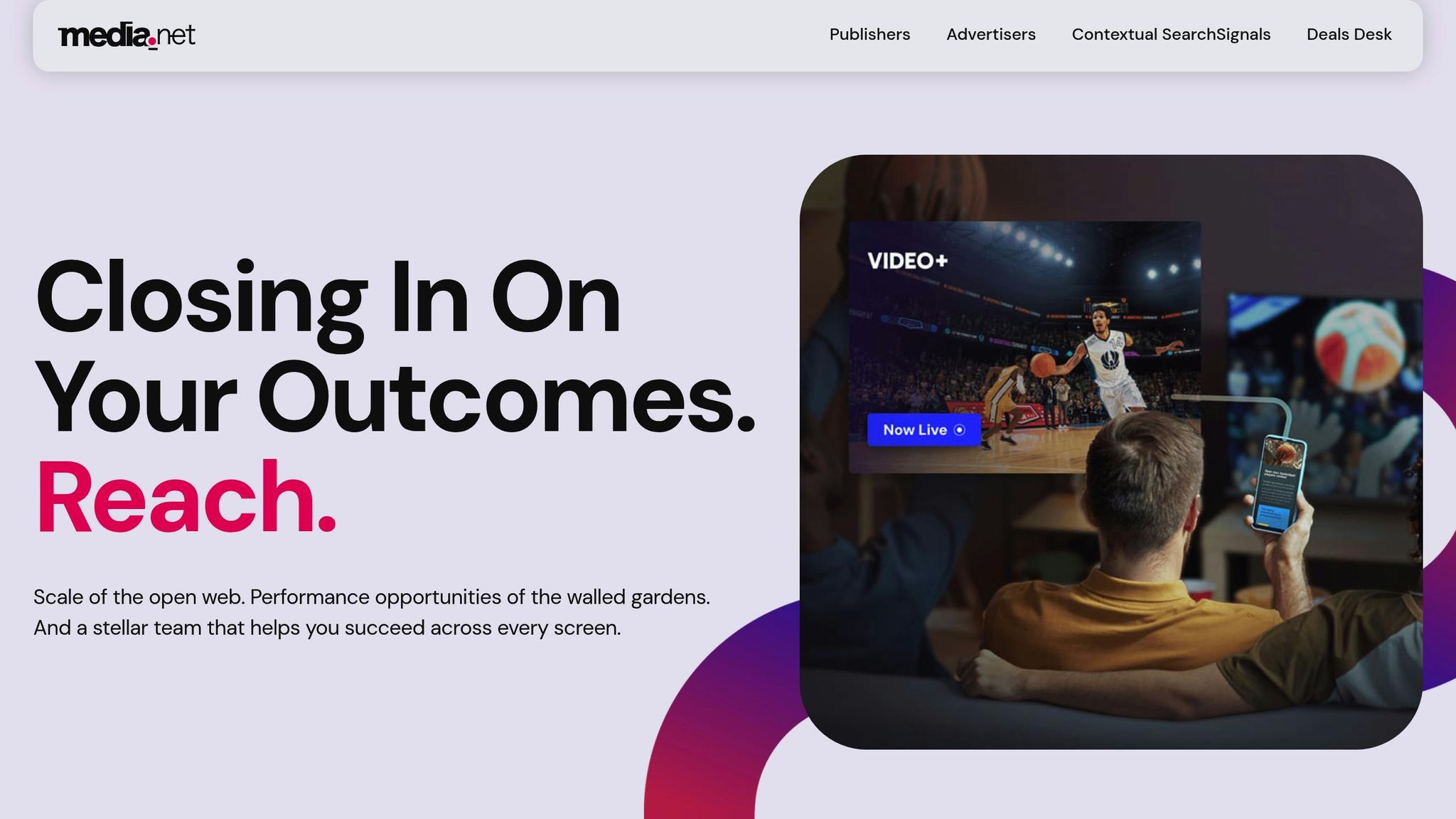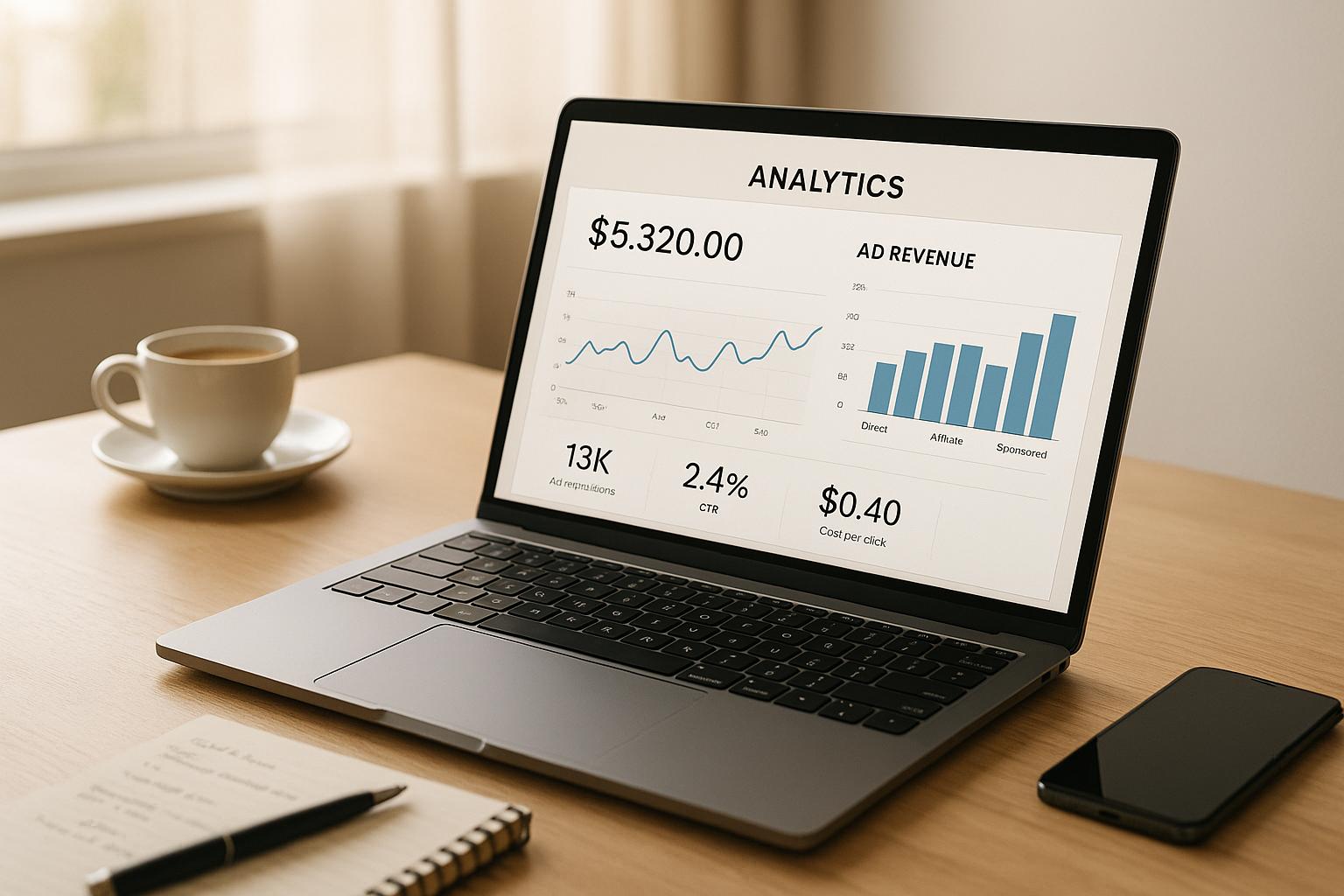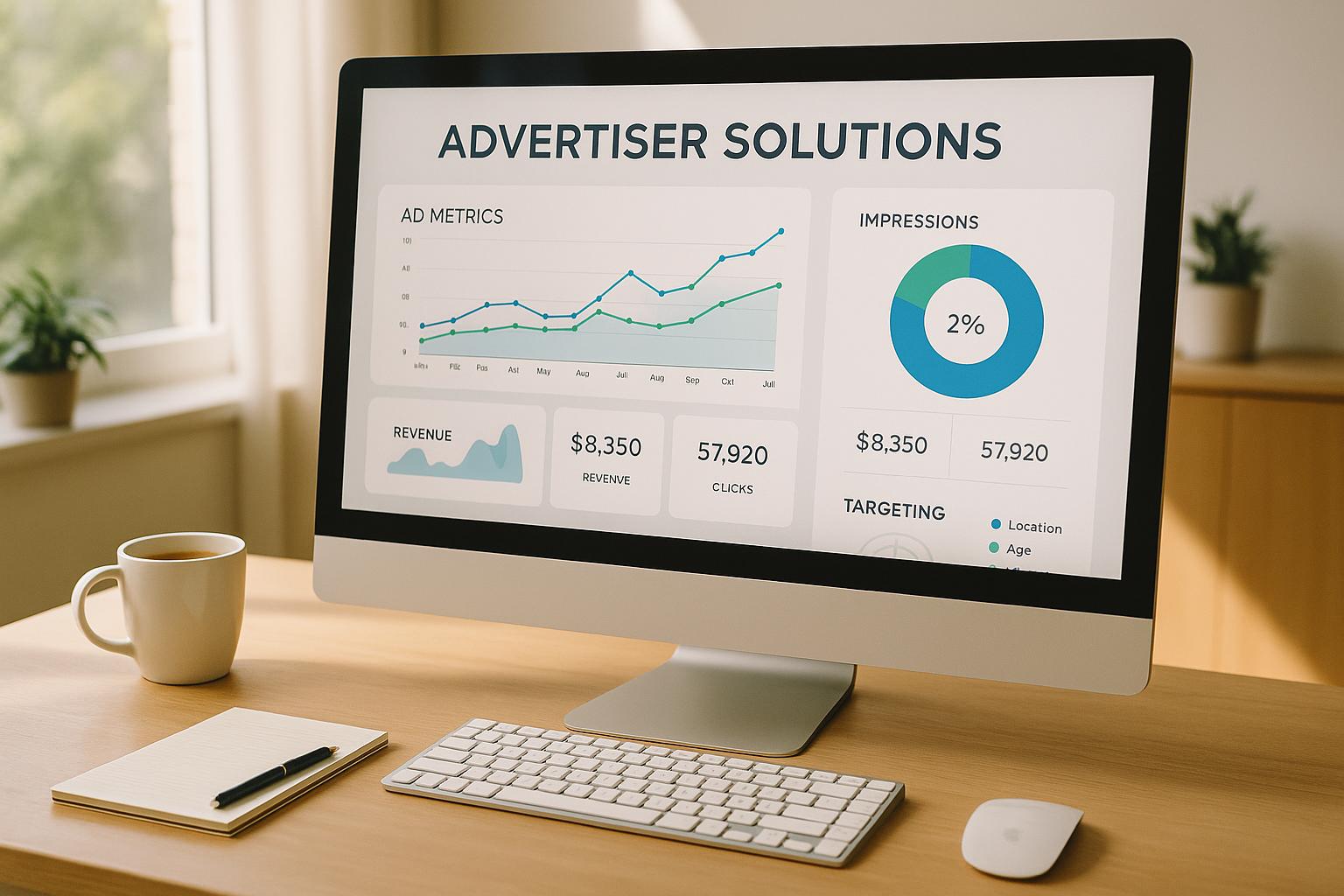Choosing the right ad network can significantly impact your revenue and user experience. Here's a quick breakdown of five popular ad networks and their key features:
- TinyAdz: Perfect for small or niche publishers with no traffic requirements. Offers banner ads, directory monetization, and detailed analytics.
- Google AdSense: A widely-used platform with flexible ad formats and advanced targeting. Works well for beginners and established publishers.
- Media.net: Focuses on contextual advertising with high relevance. Great for text-heavy websites but has stricter approval requirements.
- Ezoic: Uses AI to optimize ad placements, improving revenue and user experience. No traffic minimum, but requires DNS changes.
- Bidvertiser: Offers flexible payment models and diverse ad formats. Ideal for international publishers but may have inconsistent traffic quality.
Quick Comparison
| Network | Best For | Traffic Requirement | Key Features |
|---|---|---|---|
| TinyAdz | Niche/small publishers | None | Banner ads, no bots, detailed analytics |
| Google AdSense | Beginners/general sites | Low quality focus | Responsive ads, advanced targeting |
| Media.net | Text-heavy, established sites | Quality-focused | Contextual ads, high relevance |
| Ezoic | Optimization-focused sites | None | AI ad testing, Core Web Vitals tools |
| Bidvertiser | International publishers | None | Flexible payment models, geo-targeting |
Key Takeaways:
- For small or new publishers, TinyAdz and Google AdSense are excellent starting points.
- Established publishers with quality traffic may benefit more from Media.net or Ezoic.
- Bidvertiser is a flexible option for publishers with diverse or international audiences.
Each network has strengths and weaknesses, so consider testing multiple platforms to find the best fit for your audience and content strategy.
What is an Ad Network? The Best Ad Networks in 2025!
1. TinyAdz

TinyAdz is an ad network tailored for small websites and niche platforms, connecting advertisers with highly relevant audiences. According to a report, TinyAdz partnered with 640 sites, generating 350,000 views and 30,000 clicks in a single campaign cycle.
Focusing on quality over quantity, TinyAdz ensures 100% human traffic - no bots, no fake impressions. This makes it an attractive option for SaaS creators, newsletter publishers, bloggers, and directory owners who want to monetize their unique content while maintaining audience trust.
"TinyAdz delivers real ROI for advertisers and genuine revenue for publishers." - TinyAdz
Ad Formats
TinyAdz provides several monetization options, including:
- Banner ads
- Directory monetization
- All-site traffic campaigns
- Social media and newsletter promotions
- Event monetization
Each format is designed to help publishers generate revenue efficiently.
Traffic Requirements
TinyAdz sets itself apart by having no minimum traffic requirements. This makes it a great choice for publishers at any stage, from beginners just starting to monetize their content to those with smaller but highly engaged audiences.
Reporting Features
The platform offers detailed analytics to help publishers track campaign performance. These reports verify that all interactions are genuine, giving publishers the tools to refine their strategies and maximize earnings.
Payment Models
TinyAdz provides flexible payment options and custom campaign matching to align with publisher audiences. By focusing on high-value campaigns, the platform often achieves better engagement and overall performance. These features make TinyAdz a strong contender when compared to larger ad networks, as explored in the next sections.
2. Google AdSense

Google AdSense is one of the most widely used ad networks, powering ads on over 40 million websites and reaching an impressive 90% of internet users worldwide through the Google Display Network.
Ad Formats
Google AdSense supports a variety of ad formats, ensuring they adapt seamlessly across devices. It offers responsive display ads that automatically adjust to fit the user's screen, as well as traditional banner ads with fixed dimensions.
For instance, the 300 × 250 Medium Rectangle ad performs well on both desktop and mobile devices, while the 728 × 90 Large Leaderboard is ideal for desktop placements. For mobile users, formats like the 320 × 50 Mobile Leaderboard deliver better results by catering specifically to smaller screens.
| Dimensions (px) | Name | Device |
|---|---|---|
| 468 × 60 | Banner | Desktop/Web |
| 728 × 90 | Large Leaderboard | Desktop/Web |
| 300 × 250 | Medium Rectangle | Desktop/Web, Mobile |
| 336 × 280 | Large Rectangle | Desktop/Web |
| 320 × 50 | Mobile Leaderboard | Mobile |
To maximize visibility and engagement, publishers are encouraged to experiment with different ad sizes and layouts. The goal is to find the right balance between clarity and minimal clutter, ensuring the ads effectively blend into the site design.
Targeting Capabilities
Google AdSense leverages advanced targeting to ensure ads are highly relevant. It uses contextual targeting, which matches ads to the content on a website, and personalized targeting, which tailors ads based on user demographics and interests.
For AdSense for Search, the platform analyzes user queries to deliver ads that align with search intent. This is achieved through keyword, geographic, and demographic targeting. Publishers can also customize search boxes and results pages to match their site’s design, making the ads feel like a natural extension of the content.
Traffic Requirements
One of the standout features of Google AdSense is its flexibility regarding traffic. There’s no strict minimum traffic requirement - what matters most is the quality of the site. In fact, some websites have been approved with as few as 50 daily visits.
"It isn't traffic that matters as much as site quality." - Publisher1, Platinum Product Expert
To improve approval chances, publishers should focus on creating original, high-quality content and ensure their site includes essential pages like "About Us", "Contact Us", and "Privacy Policy." While niche sites or those targeting specific regions may benefit from aiming for 300–500 daily visits, the priority should always be building credibility through valuable content.
Reporting Features
Google AdSense goes beyond offering diverse ad formats by providing robust reporting tools to help publishers optimize their monetization strategies. Features like Search Query Reports allow publishers to identify which search terms drive the most engagement and revenue. Additionally, detailed metrics such as click-through rates (CTR) and cost-per-click (CPC) data empower publishers to make informed decisions about content and ad placement.
These insights make Google AdSense an essential tool for publishers looking to refine their advertising strategies and maximize revenue.
3. Media.net

Media.net stands as one of the largest contextual advertising networks worldwide, managing over 125 billion ads annually and generating more than 2 billion ad clicks. Back in 2016, it was acquired by Miteno Communication Technology for a staggering $900 million.
Ad Formats
Media.net provides a variety of ad formats, including search, display, video, native, and customized solutions - all accessible through a single ad tag. This streamlined approach allows publishers to easily integrate ads into their websites. Native ad units, in particular, are known to enhance click-through rates by 1.5× to 4×.
"Deploy one ad tag to access multiple ad types. Harness the power of search, display, video, native and other customized formats across all devices to suit your site and audience." - Media.net
This variety of ad types ensures a seamless fit for all kinds of websites while delivering effective contextual targeting.
Targeting Capabilities
Contextual advertising is Media.net's specialty. Its advanced algorithms analyze webpage content to pinpoint relevant keywords, ensuring precise ad placement. Unlike cookie-based systems, Media.net focuses solely on content relevance and avoids collecting audience data. Additionally, programmatic advertising based on user behavior keeps ads highly relevant, making this platform particularly effective for blogs and text-heavy sites. Publishers also benefit from detailed control over ad placements and targeting options to fine-tune their campaigns.
"With Media.net's contextually relevant & native ad units, expect increased CTRs of up to 1.5x-4x. Our contextual ads do not collect audience data and serve hyper-targeted ads relevant to your audience." - Media.net
These robust targeting capabilities make Media.net a strong choice for publishers aiming to maximize traffic and revenue.
Traffic Requirements
While Media.net doesn’t publicly share specific traffic thresholds, it places a strong emphasis on website quality and traffic sources. Traffic from tier-one countries like the United States, United Kingdom, and Canada is particularly valued. High-quality, original content also plays a major role in gaining approval, although smaller publishers might find the lack of clear traffic requirements challenging.
Payment Models
Media.net operates on a cost-per-click (CPC) model, which often leads to higher-value clicks. According to third-party reports, publishers can expect CPM earnings in the range of $1.00 to $1.25. Jake Sullivan, Director of Programmatic and Revenue Partnerships at U.S. News, highlights the platform’s strengths:
"Media.net has consistently proven as a top programmatic partner, delivering strong monetization through unique demand, robust tech, and proactive support. Their commitment to our partnership goes beyond just providing solutions - they actively seek ways to expand our revenue potential with thoughtful strategies that enhance, rather than replicate, existing offerings. This dedication to our growth, combined with their reliable support, has made Media.net an invaluable partner to our success." - Jake Sullivan, Director of Programmatic and Revenue Partnerships, U.S. News
With the capability to monetize over 1 billion URLs annually, Media.net demonstrates its scalability and effectiveness across diverse content categories. For niche publishers looking to optimize their ad revenue, this platform offers a strong and reliable solution.
sbb-itb-957fd63
4. Ezoic

Ezoic has removed all traffic requirements, making it accessible to publishers at any stage, whether they're just starting out or already established. By eliminating the previous 10,000 monthly visits threshold, Ezoic allows publishers to begin monetizing their content right away.
Ad Formats
Ezoic offers a variety of ad formats, including native, vignette, and AI-optimized auto-insert ads designed to increase both engagement and revenue. Publishers can also take advantage of anchor ads, side rails, sticky sidebar ads, and floating video ads, ensuring flexible monetization options for different website layouts.
What sets Ezoic apart is its AI ad tester, which continuously optimizes ad size, placement, and timing. This dynamic approach ensures that each ad format delivers the best results for your audience and content.
Targeting Capabilities
Ezoic's AI-powered targeting system uses user engagement patterns and advertiser data to determine the most effective ad placements. Publishers can choose from four Optimization Goals: Balanced, Revenue Focused, User Experience Focused, or Custom. These options allow the AI to adjust the number and size of ads displayed based on the selected goal.
The platform also supports testing thousands of ad placements, enabling publishers to see how different configurations impact user experience. For added control, publishers can set Ad Restrictions to disable specific ad placeholders for certain pages or directories. This level of customization, combined with seamless ad integration, maximizes monetization potential.
Reporting Features
Ezoic provides tools like LEAP optimization features and diagnostics to help publishers enhance their content and meet Google's Core Web Vitals standards. Detailed analytics on user behavior empower publishers to make informed decisions about ad placement and content strategies.
Payment Models
Ezoic's precise targeting and optimized ad formats have delivered impressive results for publishers. For example, ChromeUnboxed.com reported significant growth after partnering with Ezoic:
"We generate a substantial portion of our revenue from website ads, which means we need the best tools, support and expertise possible. We have that in Ezoic." - Joe Humphrey, Founder, ChromeUnboxed.com
Joe and Rob from ChromeUnboxed.com saw a 152% increase in revenue after adopting Ezoic. Similarly, BroadwayWorld achieved notable results, with CEO Robert Diamond reporting a 30% increase in RPS (ePMV) within the first 30 days and a 25% boost in user engagement from day one:
"With Ezoic, we have a partner that actually helped us take a more data-driven approach with our efforts. The platform has helped leverage our data to improve experiences and increase user value." - Robert Diamond, CEO, Founder, BroadwayWorld
Ezoic's ezID technology also plays a key role in boosting revenue. Sites using this system saw a 41% increase in revenue for identified visitors and a 13% increase for non-identified visitors, highlighting the platform’s ability to enhance monetization for a wide range of audiences.
5. Bidvertiser

Bidvertiser is a global advertising network that connects advertisers with a vast network of over 78,000 publishers across 196 countries. Every day, it delivers more than 400 million ads worldwide.
Ad Formats
Bidvertiser provides six different ad formats: direct navigation, pop-unders, push notifications, in-page push ads, injection pops, and native ads. These formats are designed to work seamlessly on both desktop and mobile platforms, supporting content in both mainstream and adult categories.
Targeting Capabilities
When it comes to targeting, Bidvertiser offers a range of options, including geo-targeting, device, operating system, browser, ISP, and even time-of-day targeting. It also supports subid targeting, allowing advertisers to use blacklisting, whitelisting, and bid overrides to fine-tune their campaigns. The Traffic Estimator tool is a handy feature, offering real-time daily traffic estimates and suggesting minimum bids for chosen ad formats.
Reporting Features
Bidvertiser's analytics tools make it easy to track key metrics like traffic quality, conversion rates, and revenue. The data is broken down by geography, device type, and time, giving advertisers a clear picture of campaign performance. With bid automation, advertisers can adjust their bids automatically based on preset rules, ensuring campaigns run efficiently. The reporting dashboard provides valuable insights into user behavior and performance, helping advertisers make smart, data-driven decisions.
Payment Models
Bidvertiser supports multiple payment models, including CPC, CPM, and CPA. CPC smart links start at just $0.05 per click, CPM begins at $1.00, and the CPA model rewards specific actions like sign-ups, purchases, or app installs.
"Finding the optimal match between advertisers and publishers has never been easier." - Bidvertiser
With its variety of monetization options, Bidvertiser offers flexibility to suit the diverse needs of publishers and advertisers alike.
Advantages and Disadvantages
When deciding on an ad network, it's all about balancing the pros and cons to match your goals. Every network brings its own set of benefits and challenges, which can directly influence your revenue and user experience. Here's a breakdown of some popular networks and what they offer:
TinyAdz stands out for its ability to connect niche publishers with advertisers targeting specific audiences. This makes it a great option for specialized content sites. However, since it's relatively new, its smaller pool of advertisers might limit revenue potential for larger websites.
Google AdSense is known for its simplicity and extensive advertiser network. Publishers earn 68% of revenue from display ads and 51% from search ads. While it ensures reliable payments, it lacks advanced optimization features and primarily offers support through help articles and forums.
Media.net specializes in contextual ads that integrate smoothly into content, often regarded as "the alternative to AdSense". While it ensures strong ad relevance, its stricter approval process and reliance on niche performance can be hurdles for some publishers.
Ezoic uses AI to optimize ad placements, aiming to boost revenue while maintaining user experience. It provides a 30-day free trial and then takes a 10% share of your revenue. However, some users have reported that excessive ad placements can negatively impact the overall experience.
Bidvertiser offers flexible payment options and supports various ad formats with a global reach. On the downside, its traffic quality and advertiser demand can be inconsistent compared to more established networks.
| Network | Key Advantages | Main Disadvantages | Best For |
|---|---|---|---|
| TinyAdz | Niche targeting, no traffic minimum, personalized matchmaking | Smaller advertiser pool, newer platform | Specialized content sites, new publishers |
| Google AdSense | Easy setup, reliable payments, broad reach | Limited optimization, minimal support | Beginners, general content sites |
| Media.net | Contextual relevance, good AdSense alternative | Stricter approval requirements, niche-dependent revenue | Text-heavy, established websites |
| Ezoic | AI optimization, performance focus, comprehensive support | Potential user experience issues, DNS changes needed | Publishers seeking advanced optimization |
| Bidvertiser | Multiple payment models, flexible ad formats, international reach | Inconsistent quality and variable demand | International publishers, diverse content |
To find the right fit, consider testing multiple networks. A/B testing can help you identify which platform generates the most revenue without compromising user experience. This is particularly important since one in three publisher websites fails to earn any income.
Revenue potential, support quality, and traffic requirements vary significantly across networks. Premium networks often deliver higher CPMs but demand substantial traffic, while more accessible platforms might cap earnings for high-traffic sites.
The digital advertising industry is constantly evolving. Spending is projected to reach $513 billion by 2025. However, non-video display ads are losing traction, dropping from 54% of programmatic ad spend in 2020 to an estimated 36.2% by 2026. This trend suggests publishers should consider incorporating dynamic or video ad formats to stay competitive.
Lastly, customer support can make or break your experience. While premium networks may offer dedicated account managers, free platforms often rely on self-service resources. This can be a critical factor when troubleshooting technical issues or seeking optimization advice.
Final Recommendations
The best ad network for your site depends on your traffic volume and the type of content you create. Choosing wisely ensures you get the most out of your monetization efforts. Here's a breakdown based on your site's current traffic level:
For New Publishers (Under 10,000 Monthly Visits)
If you're just starting out, TinyAdz is a great choice with its no-traffic minimum and niche-focused ad placements. Google AdSense is another solid option, offering an easy setup and dependable payments. For those willing to experiment with ad placement optimization, Ezoic can provide valuable tools to increase earnings.
For Growing Publishers (10,000–50,000 Monthly Visits)
Once your traffic grows, you can tap into networks with more advanced features and better revenue options. Look for platforms that offer premium ad quality, optimization tools, and higher CPMs to make the most of your audience.
For Established Publishers (50,000+ Monthly Visits)
If your site has significant traffic and is content-heavy, Media.net could be a strong contender. Its extensive ad inventory and focus on contextual advertising ensure high relevance for your visitors, which can lead to better engagement and revenue.
Future-Proofing Your Strategy
To keep your earnings steady - and growing - it's important to stay ahead of trends. Nonvideo display ads are projected to decline from 54% of programmatic ad spend in 2020 to 36.2% by 2026. Incorporating video or dynamic ad formats into your strategy can help you adapt to these changes.
For those already using networks like TinyAdz, Google AdSense, Media.net, Ezoic, or Bidvertiser, running A/B tests is a smart way to figure out which setups bring in the most revenue without compromising user experience. At the core, success across any network relies on two key factors: high-quality content and targeted traffic.
FAQs
What should digital publishers consider when selecting the best ad network for their needs?
When selecting an ad network, it's crucial for digital publishers to zero in on a few key aspects: how much revenue it can generate, the quality of ads it delivers, and how well it aligns with your audience. A network that complements your content type and matches your audience's demographics can make a big difference in your monetization efforts.
You’ll also want to look at how easy it is to integrate the network into your platform, the range of ad formats it offers, and its ability to provide relevant, high-quality ads. Equally important is understanding how the network balances making money with keeping your site's user experience intact. By focusing on these factors, you can find a network that aligns with your goals and keeps your audience engaged.
How does Ezoic's AI technology improve ad placement and boost revenue for publishers?
Ezoic's AI technology takes ad placement to the next level by studying detailed user behavior. It tailors ad displays for each visitor, making sure the ads they see are relevant and engaging. This personalized strategy not only captures attention but also helps boost revenue by connecting with the audience more effectively.
What sets Ezoic apart is its ability to constantly test and refine ad layouts, formats, and placements. The system adapts in real time, learning what works best for your audience. By tapping into a wealth of data, publishers can strike the perfect balance - maximizing earnings while ensuring the user experience remains smooth and enjoyable.
What are the traffic requirements and approval processes for new publishers on ad networks?
Traffic requirements and approval processes differ significantly across ad networks. Some platforms set the bar high, requiring as much as 500,000 monthly visitors to qualify. On the other hand, there are networks that welcome smaller publishers and don’t impose strict traffic minimums, making them a better fit for those just starting out.
When it comes to approvals, the process can also vary. Many platforms focus heavily on factors like the overall quality of your site, the relevance of your content, and adherence to their guidelines. This can result in a more rigorous approval process. However, some networks simplify things, offering a faster path for new publishers to begin monetizing.
While higher traffic thresholds are often tied to better ad performance and quality, there are still plenty of opportunities for publishers with smaller audiences to generate revenue from their content.


